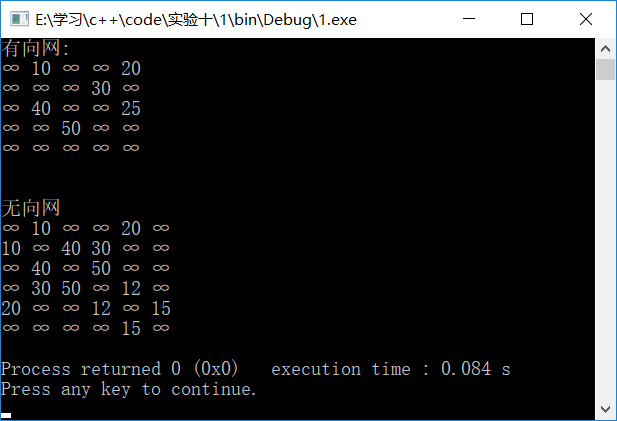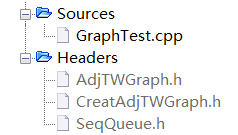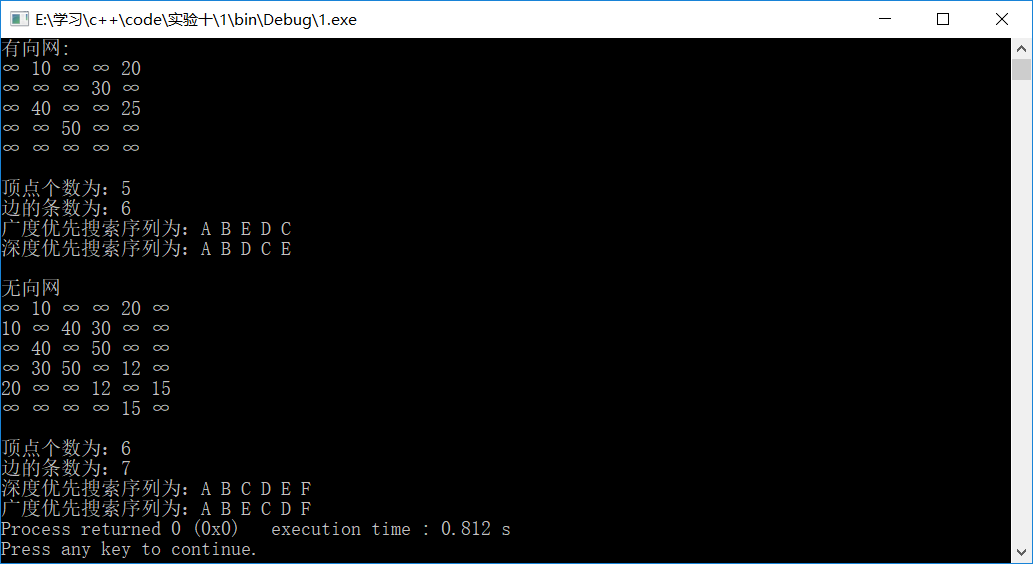大体与上次实验相同,特点为图是邻接表存储结构
--博客后半部分有程序的所有代码--
1、图邻接表存储结构表示及基本操作算法实现
所加载的库函数或常量定义及类的定义:
#include "SeqQueue.h" const int MaxVertices = 100; const int MaxWeight=10000;
(1)邻接表存储结构类定义:
struct EdgeType { int dest; DistT weight; EdgeType *next; EdgeType(){}; EdgeType(int d, DistT w): dest(d), weight(w), next(NULL){} }; struct ItemType { VerT data; EdgeType *adj; }; class AdjTWGraph { private: ItemType Vertices[MaxVertices]; int numVertices; double numOfEdges; void DepthFirstSearch(const int v, int visited[]); void BroadFirstSearch(const int v, int visited[]); public: AdjTWGraph(void); ~AdjTWGraph(void); int NumOfVertices(void) {return numVertices;} double NumOfEdges(void) {return numOfEdges;} VerT GetValue(const int i); int GetWeight(const int v1, const int v2); void Show(); //输出邻接矩阵结果 void InsertVertex(const VerT &vertex); void InsertWayEdge(const int v1, const int v2, int weight); void InsertNoWayEdge(const int v1, const int v2, int weight); void DeleteVertex(const int v); void DeleteEdge(const int v1, const int v2); int GetFirstNeighbor(const int v); int GetNextNeighbor(const int v1, const int v2); void DepthFirstSearch(); void BroadFirstSearch(); };
(2)创建邻接表算法
创建无向网邻接表算法:
void CreatNoWayWeb(AdjTWGraph &G, DataType V[],int n,RowColWeight E[], int e) { //在图G中插入n个顶点 for(int i = 0; i < n; i++) G.InsertVertex(V[i]); //在图G中插入e条边 for(int k = 0; k < e; k++) { if(E[k].row>E[k].col) { cout<<"无向网参数输入错误"; exit(0); } G.InsertNoWayEdge(E[k].row, E[k].col, E[k].weight); G.InsertNoWayEdge(E[k].col, E[k].row, E[k].weight); } }
创建有向网邻接表算法:
void CreatWayWeb(AdjTWGraph &G, DataType V[], int n,RowColWeight E[],int e) //在图G中插入n个顶点V和e条边E { //在图G中插入n个顶点 for(int i = 0; i < n; i++) G.InsertVertex(V[i]); //在图G中插入e条边 for(int k = 0; k < e; k++) G.InsertWayEdge(E[k].row, E[k].col, E[k].weight); }
(3)输出邻接表结果算法
void AdjTWGraph::Show() { for(int i=0;i<numVertices;i++) { for(int j=0;j<numVertices;j++) { int a=GetWeight(i,j); if(a==MaxWeight) cout<<"∞ "; else cout<<a<<" "; } cout<<endl; } }
测试结果粘贴如下:

2、图的遍历递归算法
(1)(存储结构为邻接表)深度优先遍历算法-递归算法
void AdjTWGraph::DepthFirstSearch() { int *visited = new int[NumOfVertices()]; for(int i = 0; i < NumOfVertices(); i++) visited[i] = 0; for(int i = 0; i < NumOfVertices(); i++) if(! visited[i]) DepthFirstSearch(i, visited); delete []visited; } void AdjTWGraph::DepthFirstSearch(const int v, int visited[]) { cout<<GetValue(v)<<" "; visited[v] = 1; int w = GetFirstNeighbor(v); while(w != -1) { if(! visited[w]) DepthFirstSearch(w, visited); w = GetNextNeighbor(v, w); } }
测试结果粘贴如下:
int main() { AdjTWGraph g,f; char a[] = {'A','B','C','D','E'}; char b[] = {'A','B','C','D','E','F'}; RowColWeight r1[] ={{0,1,10},{0,4,20},{1,3,30},{2,1,40},{3,2,50},{2,4,25}}; RowColWeight r2[] ={{0,1,10},{0,4,20},{1,3,30},{1,2,40},{2,3,50},{4,5,15},{3,4,12}}; int n1,n2,e1,e2; n1=sizeof(a)/sizeof(a[0]); n2=sizeof(b)/sizeof(b[0]); e1=sizeof(r1)/sizeof(r1[0]); e2=sizeof(r2)/sizeof(r2[0]); CreatWayWeb(g, a, n1, r1, e1); //创建有向网 CreatNoWayWeb(f, b, n2, r2, e2); //创建无向网 cout<<"有向网:"<<endl; cout << " 深度优先搜索序列为:"; g.DepthFirstSearch(); cout<<" 无向网"<<endl; cout << " 深度优先搜索序列为:"; f.DepthFirstSearch(); return 0; }
有向网/无向网的测试结果:

(2)广度优先遍历算法(递归算法)
void AdjTWGraph::BroadFirstSearch() { int *visited = new int[NumOfVertices()]; for(int i = 0; i < NumOfVertices(); i++) visited[i] = 0; for(int i = 0; i < NumOfVertices(); i++) if(!visited[i]) BroadFirstSearch(i, visited); delete []visited; } void AdjTWGraph::BroadFirstSearch(const int v, int visited[]) { VerT u, w; SeqQueue queue; cout<<GetValue(v)<<" "; visited[v] = 1; queue.Append(v); while(queue.NotEmpty()) { u = queue.Delete(); w = GetFirstNeighbor(u); while(w != -1) { if(!visited[w]) { cout<<GetValue(w)<<" ";; visited[w] = 1; queue.Append(w); } w = GetNextNeighbor(u, w); } } }
测试结果粘贴如下:
int main() { AdjTWGraph g,f; char a[] = {'A','B','C','D','E'}; char b[] = {'A','B','C','D','E','F'}; RowColWeight r1[] ={{0,1,10},{0,4,20},{1,3,30},{2,1,40},{3,2,50},{2,4,25}}; RowColWeight r2[] ={{0,1,10},{0,4,20},{1,3,30},{1,2,40},{2,3,50},{4,5,15},{3,4,12}}; int n1,n2,e1,e2; n1=sizeof(a)/sizeof(a[0]); n2=sizeof(b)/sizeof(b[0]); e1=sizeof(r1)/sizeof(r1[0]); e2=sizeof(r2)/sizeof(r2[0]); CreatWayWeb(g, a, n1, r1, e1); //创建有向网 CreatNoWayWeb(f, b, n2, r2, e2); //创建无向网 cout<<"有向网:"<<endl; cout << " 广度优先搜索序列为:"; g.BroadFirstSearch(); cout<<" 无向网"<<endl; cout << " 广度优先搜索序列为:"; f.BroadFirstSearch(); return 0; }
有向网/无向网的测试结果:
最后附上整体代码结构与结果

AdjTWGraph.h
#include "SeqQueue.h" const int MaxVertices = 100; const int MaxWeight=10000; struct EdgeType { int dest; DistT weight; EdgeType *next; EdgeType(){}; EdgeType(int d, DistT w): dest(d), weight(w), next(NULL){} }; struct ItemType { VerT data; EdgeType *adj; }; class AdjTWGraph { private: ItemType Vertices[MaxVertices]; int numVertices; double numOfEdges; void DepthFirstSearch(const int v, int visited[]); void BroadFirstSearch(const int v, int visited[]); public: AdjTWGraph(void); ~AdjTWGraph(void); int NumOfVertices(void) {return numVertices;} double NumOfEdges(void) {return numOfEdges;} VerT GetValue(const int i); int GetWeight(const int v1, const int v2); void Show(); //输出邻接矩阵结果 void InsertVertex(const VerT &vertex); void InsertWayEdge(const int v1, const int v2, int weight); void InsertNoWayEdge(const int v1, const int v2, int weight); void DeleteVertex(const int v); void DeleteEdge(const int v1, const int v2); int GetFirstNeighbor(const int v); int GetNextNeighbor(const int v1, const int v2); void DepthFirstSearch(); void BroadFirstSearch(); }; AdjTWGraph::AdjTWGraph(void) { for(int i = 0; i < MaxVertices; i++) Vertices[i].adj = NULL; numVertices = 0; numOfEdges = 0; } AdjTWGraph::~AdjTWGraph(void) { for(int i = 0; i < numVertices; i++) { EdgeType *p = Vertices[i].adj, *q; while(p != NULL) { q = p->next; delete p; p = q; } } } VerT AdjTWGraph::GetValue(const int i) { if(i < 0 || i > numVertices) { cout << "参数i越界出错!" << endl; exit(0); } return Vertices[i].data; } int AdjTWGraph::GetWeight(const int v1, const int v2) { if(v1 < 0 || v1 > numVertices || v2 < 0 || v2 > numVertices) { cout << "参数v1或v2越界出错!" << endl; exit(0); } EdgeType *p = Vertices[v1].adj; while(p != NULL && p->dest < v2) p = p->next; if(p==NULL||v2 != p->dest) { return MaxWeight; } return p->weight; } void AdjTWGraph::InsertVertex(const VerT &vertex) { Vertices[numVertices].data = vertex; numVertices++; } void AdjTWGraph::InsertWayEdge(const int v1, const int v2, int weight) { if(v1 < 0 || v1 > numVertices || v2 < 0 || v2 > numVertices) { cout << "参数v1或v2越界出错!" << endl; exit(0); } EdgeType *q = new EdgeType(v2, weight); if(Vertices[v1].adj == NULL) Vertices[v1].adj = q; else { EdgeType *curr = Vertices[v1].adj, *pre = NULL; while(curr != NULL && curr->dest < v2) { pre = curr; curr = curr->next; } if(pre == NULL) { q->next = Vertices[v1].adj; Vertices[v1].adj = q; } else { q->next = pre->next; pre->next = q; } } numOfEdges++; } void AdjTWGraph::InsertNoWayEdge(const int v1, const int v2, int weight) //插入一条起始顶点为v1、终止顶点为 v2、权值为weight的边 { if(v1 < 0 || v1 > numVertices || v2 < 0 || v2 > numVertices) { cout << "参数v1或v2越界出错!" << endl; exit(0); } EdgeType *q = new EdgeType(v2, weight); if(Vertices[v1].adj == NULL) Vertices[v1].adj = q; else { EdgeType *curr = Vertices[v1].adj, *pre = NULL; while(curr != NULL && curr->dest < v2) { pre = curr; curr = curr->next; } if(pre == NULL) { q->next = Vertices[v1].adj; Vertices[v1].adj = q; } else { q->next = pre->next; pre->next = q; } } numOfEdges+=0.5; //边的个数加0.5 } void AdjTWGraph::DeleteVertex(const int v) { EdgeType *pre, *curr; for(int i = 0; i < numVertices; i++) { pre = NULL; curr = Vertices[i].adj; while(curr != NULL && curr->dest < v) { pre = curr; curr = curr->next; } if(pre == NULL && curr->dest == v) { Vertices[i].adj = curr->next; delete curr; numOfEdges--; } else if(curr != NULL && curr->dest == v) { pre->next = curr->next; delete curr; numOfEdges--; } } EdgeType *p = Vertices[v].adj, *q; for(int i = v; i < numVertices-1; i++) Vertices[i] = Vertices[i+1]; numVertices--; while(p != NULL) { q = p->next; delete p; p = q; numOfEdges--; } } void AdjTWGraph::DeleteEdge(const int v1, const int v2) { if(v1 < 0 || v1 > numVertices || v2 < 0 || v2 > numVertices) { cout << "参数v1或v2越界出错!" << endl; exit(0); } EdgeType *curr = Vertices[v1].adj, *pre = NULL; while(curr != NULL && curr->dest < v2) { pre = curr; curr = curr->next; } if(pre == NULL && curr->dest == v2) { Vertices[v1].adj = curr->next; delete curr; numOfEdges--; } else if(pre != NULL && curr->dest == v2) { pre->next = curr->next; delete curr; numOfEdges--; } else { cout << "边<v1, v2>不存在!" << endl; exit(0); } } int AdjTWGraph::GetFirstNeighbor(const int v) { if(v < 0 || v > numVertices) { cout << "参数v1越界出错!" << endl; exit(0); } EdgeType *p = Vertices[v].adj; if(p != NULL) return p->dest; else return -1; } int AdjTWGraph::GetNextNeighbor(const int v1, const int v2) { if(v1 < 0 || v1 > numVertices || v2 < 0 || v2 > numVertices) { cout << "参数v1或v2越界出错!" << endl; exit(0); } EdgeType *p = Vertices[v1].adj; while(p != NULL) { if(p->next != NULL && p->dest == v2) return p->next->dest; else p = p->next; } return -1; } void AdjTWGraph::DepthFirstSearch() { int *visited = new int[NumOfVertices()]; for(int i = 0; i < NumOfVertices(); i++) visited[i] = 0; for(int i = 0; i < NumOfVertices(); i++) if(! visited[i]) DepthFirstSearch(i, visited); delete []visited; } void AdjTWGraph::DepthFirstSearch(const int v, int visited[]) { cout<<GetValue(v)<<" "; visited[v] = 1; int w = GetFirstNeighbor(v); while(w != -1) { if(! visited[w]) DepthFirstSearch(w, visited); w = GetNextNeighbor(v, w); } } void AdjTWGraph::BroadFirstSearch() { int *visited = new int[NumOfVertices()]; for(int i = 0; i < NumOfVertices(); i++) visited[i] = 0; for(int i = 0; i < NumOfVertices(); i++) if(!visited[i]) BroadFirstSearch(i, visited); delete []visited; } void AdjTWGraph::BroadFirstSearch(const int v, int visited[]) { VerT u, w; SeqQueue queue; cout<<GetValue(v)<<" "; visited[v] = 1; queue.Append(v); while(queue.NotEmpty()) { u = queue.Delete(); w = GetFirstNeighbor(u); while(w != -1) { if(!visited[w]) { cout<<GetValue(w)<<" ";; visited[w] = 1; queue.Append(w); } w = GetNextNeighbor(u, w); } } } void AdjTWGraph::Show() { for(int i=0;i<numVertices;i++) { for(int j=0;j<numVertices;j++) { int a=GetWeight(i,j); if(a==MaxWeight) cout<<"∞ "; else cout<<a<<" "; } cout<<endl; } }
CreatAdjTWGraph.h
struct RowColWeight { int row; //行下标 int col; //列下标 int weight; //权值 }; void CreatWayWeb(AdjTWGraph &G, DataType V[], int n,RowColWeight E[],int e) //在图G中插入n个顶点V和e条边E { //在图G中插入n个顶点 for(int i = 0; i < n; i++) G.InsertVertex(V[i]); //在图G中插入e条边 for(int k = 0; k < e; k++) G.InsertWayEdge(E[k].row, E[k].col, E[k].weight); } void CreatNoWayWeb(AdjTWGraph &G, DataType V[],int n,RowColWeight E[], int e) { //在图G中插入n个顶点 for(int i = 0; i < n; i++) G.InsertVertex(V[i]); //在图G中插入e条边 for(int k = 0; k < e; k++) { if(E[k].row>E[k].col) { cout<<"无向网参数输入错误"; exit(0); } G.InsertNoWayEdge(E[k].row, E[k].col, E[k].weight); G.InsertNoWayEdge(E[k].col, E[k].row, E[k].weight); } }
SeqQueue.h
#include<iostream> using namespace std; class SeqQueue { private: DataType data[MaxQueueSize]; //顺序队列数组 int front; //队头指示器 int rear; //队尾指示器 int count; //元素个数计数器 public: SeqQueue(void) //构造函数 {front = rear = 0; count = 0;}; ~SeqQueue(void){}; //析构函数 void Append(const DataType& item); //入队列 DataType Delete(void); //出队列 DataType GetFront(void)const; //取队头数据元素 int NotEmpty(void)const //非空否 {return count != 0;}; }; void SeqQueue::Append(const DataType& item) //入队列 //把数据元素item插入队列作为当前的新队尾 { if(count > 0 && front == rear) { cout << "队列已满!" << endl; exit(0); } data[rear] = item; //把元素item加在队尾 rear = (rear + 1) % MaxQueueSize; ///队尾指示器加1 count++; //计数器加1 } DataType SeqQueue::Delete(void) //出队列 //把队头元素出队列,出队列元素由函数返回 { if(count == 0) { cout << "队列已空!" << endl; exit(0); } DataType temp = data[front]; //保存原队头元素 front = (front + 1) % MaxQueueSize; //队头指示器加1 count--; //计数器减1 return temp; //返回原队头元素 } DataType SeqQueue::GetFront(void)const //取队头数据元素 //取队头元素并由函数返回 { if(count == 0) { cout << "队列空!" << endl; exit(0); } return data[front]; //返回队头元素 }
GraphTest.cpp
#include <iostream> #include <stdlib.h> const int MaxQueueSize = 100; typedef char VerT; typedef int DistT; typedef char DataType; #include "AdjTWGraph.h" #include "CreatAdjTWGraph.h" int main() { AdjTWGraph g,f; char a[] = {'A','B','C','D','E'}; char b[] = {'A','B','C','D','E','F'}; RowColWeight r1[] ={{0,1,10},{0,4,20},{1,3,30},{2,1,40},{3,2,50},{2,4,25}}; RowColWeight r2[] ={{0,1,10},{0,4,20},{1,3,30},{1,2,40},{2,3,50},{4,5,15},{3,4,12}}; int n1,n2,e1,e2; n1=sizeof(a)/sizeof(a[0]); n2=sizeof(b)/sizeof(b[0]); e1=sizeof(r1)/sizeof(r1[0]); e2=sizeof(r2)/sizeof(r2[0]); CreatWayWeb(g, a, n1, r1, e1); //创建有向网 CreatNoWayWeb(f, b, n2, r2, e2); //创建无向网 cout<<"有向网:"<<endl; g.Show(); cout << " 顶点个数为:" << g.NumOfVertices(); cout << " 边的条数为:" << g.NumOfEdges(); cout << " 广度优先搜索序列为:"; g.BroadFirstSearch(); cout << " 深度优先搜索序列为:"; g.DepthFirstSearch(); cout<<" 无向网"<<endl; f.Show(); cout << " 顶点个数为:" << f.NumOfVertices(); cout << " 边的条数为:" << f.NumOfEdges(); cout << " 深度优先搜索序列为:"; f.DepthFirstSearch(); cout << " 广度优先搜索序列为:"; f.BroadFirstSearch(); return 0; }
最终结果

